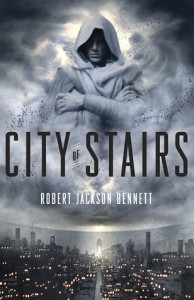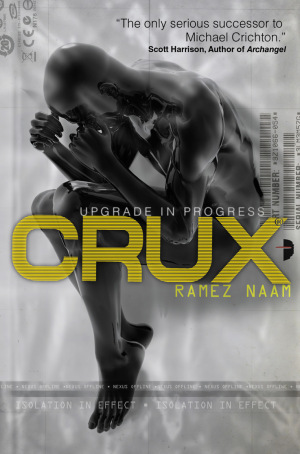Welcome to Smugglivus 2014! Throughout this month, we will have daily guests – authors and bloggers alike – looking back at their favorite reads of 2014, looking forward to events and upcoming books in 2015, and more.
Who: Robert Jackson Bennett, Speculative fiction writer extraordinaire. RJB’s most recent work is the excellent novel City of Stairs, loved by all, including Ana.
Give a warm welcome to RJB, folks!
Near future stories are an increasingly tough medium to work in. This has been the case for a while now – for example, the events of Blade Runner are now only a handful of years away, according to the film’s timeline, and we’ve yet to see any flying cars or offworld colonies – but the conditions have become even more extreme in the past decade. Between emerging technologies with exponential consequences and mankind’s own impact upon planet Earth, the future is more in flux than ever before. Predicting anything more than five or ten years out is little more than a guessing game.
William Gibson tweeted about this when the near-future SF romance film Her came out last year. It’s a good story, but he kept asking – how’d you fix the climate? How’d you fix overpopulation? How are you feeding all these people? In this particular instance, I’d say Her is utterly disinterested in being a realistic near-future story, but the point remains. Even if you’re taking in something that’s as happily fantastical as Her, your nagging doubts persist. “I just saw the news when I walked into this story,” you think to yourself. “I can’t forget that a very unstable reality is unfolding out there.”
All this is probably why I enjoy Ramez Naam’s Nexus books as much as I do. Naam’s near-future stories of a technologically altered world have suggestions of idealism to them, but they’re tempered with a healthy dose of realism: he disdains both the utopic Kurzweillian vision of a future of abundance and limitless possibility, as well as the lurid, miserable pessimism of a post-apocalyptic future in which humanity is endlessly punished for its sins. Rather than indulging in the optimism of the pseudo-prophetic Singularity or the furious self-flagellation of dystopia, his stories envision a world in which plausible but highly advanced technologies have had an outsized but realistic effect on humanity, often in very striking ways.
The story setup is a familiar one: in the near future (in this case, 2040), mankind has become so adept at manipulating technology and biology that it has begun to physically advance itself, mostly at the individual level in the time of the novels. The more mundane examples include gene hacking, muscle augmentation, cloning, and various sensory augmentations, but Naam is chiefly interested in perhaps that most disruptive and seemingly benign of technologies: communications.
Specifically, brain-to-brain communications. In his story, the drug “Nexus” consists of tiny nanites that, when ingested, bond to the synapses in the human brain, allowing minds to communicate wirelessly. The protagonist, Kaden Lane, has developed an advanced from of the drug that allows it to permanently stay within the human system, rather than slowly being flushed out. Nexus-users are now “post-human” or “trans-human,” existing in a fundamentally different state.
Naam fully explores the implications of this: Nexus doesn’t just share thoughts like garden variety telepathy, but allows users to share feelings, memories, sensations, and emotions, as well as allowing humans to directly control their own brains, forcing it to boost things like adrenaline and dopamine at will. Though at first the drug is primarily used at parties – users dance in a rave, sharing each other’s minds in an ecstatic, near-orgasmic state – it quickly proves to have other, larger effects: teams of researchers with Nexus are able to communicate faster, forming a nebulous, data-sharing single mind that produces solutions far faster than separate humans. Autistic children are able to use it to communicate perhaps for the first time in their lives, wordlessly articulating what was previously impossible. Alzheimer’s patients, as well, are able to slow the spread of the disease, using the nanites to activate specific synapses that would ordinarily go dormant.
And, as always, advertising follows: if you walk by a store with Nexus broadcasts, it can put the sensation of what it’s selling right inside your mind. Sometimes it’s as simple as the taste of an orange soda. The scene where Nexus users pass a brothel, however, is particularly amusing. And Naam doesn’t shy away from the more perverse uses of the drug: one of the central conceits of the story is that technology is a tool to be wielded by the user however they wish, so just as we have hacking, bullying, and internet theft today, with Nexus one can hack in and control other users, an act frequently compared to rape in the books.
The other major issue is that the drug, of course, is extremely illegal. After something like a biotech 9/11 in America, the Emerging Risks Directorate (something like the Department of Homeland Security of this era) is allowed to seek out and detain or eliminate any trans-human or post-human technologies or users. Anyone using tech to augment their own bodies is considered either a criminal or a terrorist. Naam evokes a chillingly plausible manner in which this is executed, and shows a particularly deft hand at describing remote and drone technologies used in this persecution: the reader finds themselves both thrilled and disgusted with humanity’s ability to wage war, invisibly, from the skies.
But unlike a lot of fiction, SF or otherwise, Naam isn’t interested solely in America. Nexus is a book with global concerns, and both it and its sequel, Crux, mostly take place in the East, particularly China, Vietnam, and Thailand. There Naam explores ways developing countries embrace technology: not only is Nexus permissible in parts of these countries (China, specifically, is heavily invested in it), but things like gene hacked crops are not only allowed but critical to survival. Naam paints a realistic portrait in which developed countries have the privilege of disdaining technologies it finds controversial while poorer ones, suffering from climate change and other maladies, have no option but to embrace them. This phenomenon – “leapfrogging” – is, like many things in Nexus, happening right now in this world: just as Naam’s Vietnamese monks embrace gene hacked crops, parts of Africa are moving into a wholly-mobile currency, and developing countries are embracing renewable energy like solar and wind at astonishing rates. Naam simply takes things a step further, envisioning a world in which telecommunications could potentially foster a previously unthinkable global state, starting in the developing countries while “First World” nations remain steadfastly technophobe.
And that’s what Naam and most of his characters are interested in: the staggering implications of Nexus for the entirety of the human species. In our contemporary real world, communication has become easier by magnitudes in recent years: not only can we instantaneously publish text, image, and video, but now you might be reading this very text on your phone in a car. But Naam imagines a true game changer. With Nexus, countries and borders dissolve as users from one country share the experiences of those on the other side of the planet, with no language barrier and no time lapse. And with Nexus, information – the river all authorities everywhere will forever attempt to dam up and control – can travel at such a speed as to make mobile technologies appear trundling and asthmatic.
Nexus takes the next step when some children born to mothers carrying the drug are capable of hosting the drug themselves, wirelessly communicating from the womb and beyond. The idea of children experiencing concepts and sensations from before birth has huge implications: they learn languages and societal protocols before they can even walk or talk, outpacing children much older than them. The drug Nexus fundamentally reshapes the way they learn, the way their information is communicated. When they mature – if the world of Nexus will allow them to survive to be mature, that is – they will be different creatures from any human before them.
As I watch my own son deftly maneuver through any number of mobile platforms at the age of three, it’s this possibility that most excites and intimidates me, and Naam captures this sensation quite well: the characters in the novel are sometimes struck with the queasy realization that, though technological advances have had enormous impacts on their own lives, for their children, these advances will foster a whole new world. I share their optimism, their exultation, their melancholy, and their dread. I know the differences between my world and my son’s world will be several orders of magnitude bigger than the difference between my father’s and my own. Will my son one day use technology to speak a language I will be deaf to? I am often given to wonder.
Naam completes the Nexus trilogy in May of 2015. I look forward to it with both anticipation and no small amount of anxiety.
Thank you, RJB!














2 Comments
Chris
December 5, 2014 at 5:44 amNice Blog!
For me, I love to read a nice holiday story at this time of the year. As of now, I am reading my all time favorite Christmas book ‘The Special Guest’ by Lee Allen. I read it the first time 20 years back and was lucky to get my hands on the special 20th Anniversary edition!
Laure Reminick
December 8, 2014 at 5:25 pmNear-future tales that don’t simply fall into the post-apocalyptic fugue–sounds wonderful. These go on my To Read list. Thanks